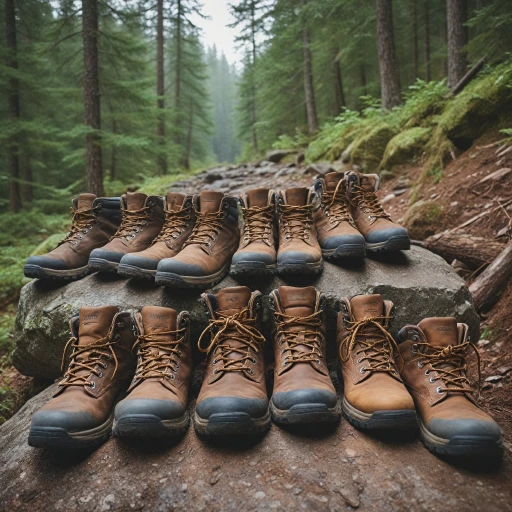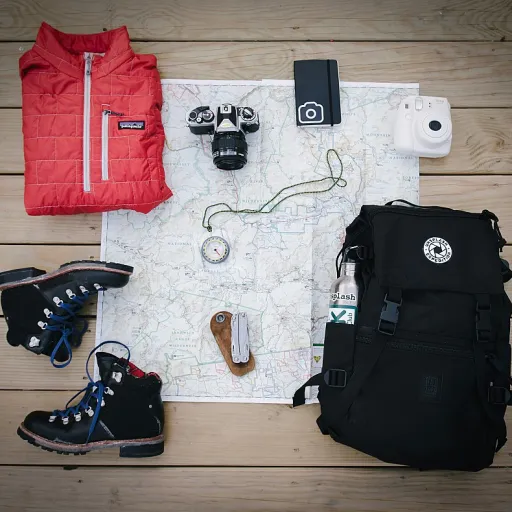
Understanding Plantar Fasciitis and Its Impact on Hiking
Discovering the Challenges Faced by Hikers with Plantar Fasciitis
Plantar fasciitis, a common foot ailment, can heavily impact a hiker's experience. It involves inflammation of the plantar fascia, a thick band of tissue that runs across the bottom of the foot connecting the heel bone to the toes. This condition is known to cause significant heel pain, particularly in the morning or after long periods of standing or walking.
For hiking enthusiasts, the right footwear is essential to alleviating this discomfort. Shoes that offer adequate arch support can provide relief by reducing the strain on the plantar fascia. In addition, hikers with plantar fasciitis benefit from shoes with a low drop, which ensures an even distribution of pressure on the foot.
Notably, hikers with this condition often require a wide toe box in their hiking boots. This feature allows the feet to splay naturally, reducing pressure on the heel and arch while enhancing stability. Such considerations obligate hikers to look for the best in shoe technology that caters to heel support and extends overall comfort during long walks.
For those researching footwear solutions on platforms like Amazon, customer reviews and ratings can be pivotal in decision-making. Many brands now cater to individuals with plantar fasciitis, offering products specifically rated for their comfort and pain relief efficiency. Products boasting a high star rating often feature thoughtful design elements such as stack height customization for varied foot needs, making them suitable candidates for further exploration.
Understanding these aspects prepares hikers with plantar fasciitis to make informed decisions and enhance their hiking adventures. It is not only about selecting the right shoe type, whether barefoot shoes, running shoes, or specialized walking shoes, but also understanding the supplemental features that can make or break comfort on the trail.
The Importance of a Wide Toe Box in Hiking Boots
The Critical Role of Toe Box Width in Hiking Comfort
For those dealing with plantar fasciitis, selecting the right footwear can be crucial to ensuring comfort during hiking excursions. One of the most essential considerations is the design and width of the toe box. A wide toe box can accommodate the natural spread of your feet while you walk or hike, which is especially important for individuals with wide feet or those suffering from heel pain. With plantar fasciitis often leading to increased sensitivity and discomfort, pressure on the plantar fascia should be minimized as much as possible. A tight toe box can exacerbate symptoms by compressing the toes and the ball of the foot, potentially worsening pain. By allowing sufficient space, hikers can benefit from reduced friction, which translates to fewer blisters and more sustained energy expenditure on the trail. In addition to providing direct comfort, a generous toe box can offer effective pain relief for those with inflamed plantar fascia by reducing stress on the heel and arch. Look for hiking boots that not only promise stability with excellent arch support but also prioritize a wider toe area. Many users searching for the best solutions have turned to platforms like Amazon to find highly rated footwear that meets these specific needs. For an in-depth perspective on materials and options, exploring the best men's Gore-Tex boots for hiking adventures can provide insight into brands that excel in this aspect of boot design. Understanding the product details, including features like stack height, can also influence your decision on which hiking boots offer the best support, ultimately enhancing your hiking experience.Features to Look for in Hiking Boots for Plantar Fasciitis
Essential Features for Plantar Fasciitis Relief
When it comes to hiking boots suitable for plantar fasciitis, certain features are indispensable to ensure comfort and efficacy during hikes. Prioritizing the right characteristics can significantly alleviate the pains associated with this condition.
A wide toe box is crucial as it provides ample space for toes to spread naturally, reducing pressure on the plantar fascia. This extra room is particularly beneficial for individuals with wide feet, allowing for improved balance and stability.
Seek boots with excellent arch support. Proper arch support helps distribute weight evenly across the foot, minimizing the strain on the heel and arch areas. High stack height can also contribute to cushioning, which is advantageous when traversing rough terrains.
Heel support is another critical feature, as it helps stabilize the foot and reduce heel pain. A rigid heel counter ensures that the foot remains secure, providing the necessary support during vigorous movements.
When browsing amazon or reading a full review of footwear, consider the footwear's drop and its suitability for your foot needs. A lower drop encourages a more natural walking motion akin to barefoot shoes, which can be advantageous for those seeking pain relief. Altra running shoes are known for their zero-drop platforms, making them a popular choice among individuals dealing with plantar fasciitis.
Lastly, consider the product details, such as the durability and material of the boot. Quality materials contribute to the longevity of the shoes, reducing the need for frequent replacements. Regularly rated on a scale of comfort and support, investing in the best boots for plantar fasciitis ensures a more enjoyable and pain-free hiking experience. For more insights on versatile outdoor gear, explore the versatility of related hiking gear.
Top Hiking Boot Brands Offering Wide Toe Box Options
Leading Brands Offering Wide Toe Box Solutions
For individuals grappling with plantar fasciitis, finding hiking boots that cater specifically to your needs is essential. Among the key features to seek is a wide toe box, which grants your feet ample space and reduces pressure on your toes, crucial for managing heel pain related to plantar fasciitis. Several trusted brands have risen to the occasion by offering models that excel in both comfort and support.- Altra Running: Known for their signature barefoot shoe feel, Altra Running excels in arches and support, offering shoes with remarkable plantar fascia support and wider toe boxes to accommodate wide feet comfortably.
- Keen Footwear:** Renowned for crafting quality footwear, Keen expertly combines durable materials and design with extra wide toe boxes, offering walking shoes that make every step a pleasure.
- Merrell:** Offering shoes with commendable heel support and arch support, Merrell ensures that their products meet the needs of those with plantar fasciitis. Their wide toe box designs are a testament to their understanding of diverse foot structures.
- The North Face: Beyond their robust outdoor gear, The North Face's hiking boots are highly rated for their stack height and support, often highlighted in full product reviews for their spacious toe areas.
- Hoka One One: This brand is best known for shoes that emphasize cushioning and high stack height, offering significant pain relief for those enduring plantar fasciitis. Their commitment to comfort and engineered wide toe designs makes walking and hiking a more comfortable experience.
Tips for Selecting the Right Hiking Boots
Finding the Perfect Pair for Your Needs
Let's delve into a few practical tips for selecting the perfect hiking boots to tackle plantar fasciitis comfortably and effectively.
- Consider Arch Support: Shoes that offer excellent arch support are essential for those battling plantar fasciitis. This support can alleviate heel pain and distribute pressure evenly across the foot. Look for footwear specifically designed with plantar comfort in mind, often labeled with features such as "arch support" or "designed for plantar fasciitis."
- Prioritize Fit and Width: Since foot width varies, opting for boots that offer a wide toe box can be a game changer. A well-fitted shoe prevents unnecessary pressure, particularly important for those with wide or extra wide feet. This is crucial in minimizing pain and discomfort when hiking.
- Stack Height and Heel Drop: Check the product details for stack height and heel drop when choosing shoes. A moderate heel drop can provide a balance between stability and natural foot movement, helping to reduce strain on the plantar fascia.
- Ratings and Reviews: Take the time to read full reviews and feedback from other hikers. Their experiences can provide valuable insights into what works and what doesn’t, reflected in rated scales and amazon stars.
- Try Different Brands: Explore various hiking boot brands like Altra Running, known for their generous toe boxes and support features. Compare models to find what aligns best with your foot shape and walking needs.
- Test Before You Buy: Trying boots before purchase allows you to feel how supportive and comfortable they are for your unique foot. Visit outdoor stores where you can walk or even run in the boots to ensure optimal comfort and pain relief, similar to testing barefoot shoes or running shoes.
Choosing the right hiking boots is pivotal in turning your hiking adventures from painful to pleasant. By following these guidelines, you'll be better equipped to find footwear that can provide the necessary support and cushioning for your plantar fasciitis condition.
Caring for Your Hiking Boots to Extend Their Lifespan
Maximize the Lifespan of Your Hiking Boots
Proper maintenance of your hiking boots is crucial to ensure comfort, especially if you are dealing with plantar fasciitis. Investing in shoes with a wide toe box and excellent arch support is only part of the journey. To get the best out of these supportive shoes, regular care is essential.- Clean Regularly: After each adventure, remove dirt and debris from your footwear. This not only helps maintain the shoe's appearance but also prevents material degradation. Use a soft brush to tackle mud and a damp cloth for lighter dirt.
- Dry Properly: Avoid exposing your boots to direct heat sources like a radiator. Instead, stuff them with newspaper to absorb moisture and help maintain the shape, especially crucial for those extra wide styles required for wide feet.
- Apply Waterproofing Treatments: Regularly applying a suitable waterproofing agent can prevent water from entering the shoes, ensuring your feet remain dry and reducing potential heel pain associated with damp conditions.
- Check the Soles: Ensure that the sole offers adequate traction. Regular inspection for any damage or significant wear is vital. Worn out soles not only affect foot and heel support but can also exacerbate plantar fasciitis symptoms.
- Rotate Footwear: If possible, alternate between pairs of hiking boots. This gives each pair time to air out between uses, preserving their durability and maintaining the supportive structure essential for those with sensitive plantar fascia.
- Store with Care: When not in use, store your boots in a cool, dry place. Proper storage helps maintain their structure and provide consistent pain relief on your next walking or hiking excursion.














